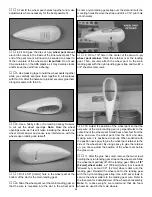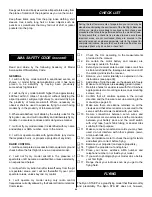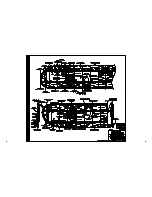
3. The ideal power source for the Ryan STA EP is a 7-cell,
8.4 volt 1700 – 3000 mAh battery pack. The use of a higher
voltage battery may reduce the motor life and damage the
electronic speed control.
1. A new battery pack should be “cycled” for best results.You
should peak charge the battery, then discharge it almost
completely by actually running your motor with the propeller
attached. Do this 2 or 3 times on the ground before actually
flying. Be sure you remove the battery from the airplane
between each cycle and allow it and the motor to cool
before recharging.
2. The standard Tamiya battery connectors supplied with
your electronic speed control and motor battery are
adequate for most installations. However, if you are looking
for maximum performance, you may want to consider
installing high-performance battery connectors such as
DuraTrax
®
Powerpole
™
connectors (DTXC2300).
3. Examine your propeller for irregularities caused by the
injection molding process. Carefully remove the imperfections
with fine sandpaper.
Carefully balance your propeller and spare propellers before
you fly. An unbalanced prop can be the single most
significant cause of vibration that can damage your model.
Not only will motor mounting screws and bolts loosen,
possibly with disastrous effect, but vibration may also
damage your radio receiver and battery.
We use a Top Flite Precision Magnetic Prop Balancer
™
(TOPQ5700) in the workshop and keep a Great Planes
Fingertip Prop Balancer (GPMQ5000) in our flight box.
The best place to fly your Ryan STA EP is at an AMA
chartered club field. Ask the AMA or your local hobby shop
dealer it there is a club in your area and join. Club fields are
set up for R/C flying and that makes your outing safer and
more enjoyable. The AMA also can tell you the name of a
club in your area. We recommend that you join the AMA and
a local club so you can have a safe place to fly and have
insurance to cover you in case of a flying accident. The AMA
address and telephone number are in the front of this manual.
If a club and flying site are not available, find a large, grassy
area at least 6 miles away from houses, buildings and
streets and any other R/C radio operation like R/C boats
and R/C cars. A schoolyard may look inviting but is too close
to people, power lines and possible radio interference.
After you break-in the motor on the model, inspect the
model closely to make sure all screws remained tight, the
hinges are secure, the prop is secure and all pushrods and
connectors are secure.
Whenever you go to the flying field, check the operational
range of the radio before the first flight of the day. First,
make sure no one else is on your frequency (channel). Have
an assistant hold the model, staying clear of the prop. With
your transmitter on, you should be able to walk at least 100
feet away from the model and still have control. While you
work the controls, have your assistant tell you what the
control surfaces are doing. Repeat this test with the motor
running at various speeds. If the control surfaces are not
always responding correctly, do not fly! Find and correct the
problem first. Look for loose servo connections or corrosion,
loose bolts that may cause vibration, a defective on/off
switch, low battery voltage, a damaged receiver antenna, or
a receiver crystal that may have been damaged from a
previous crash. If the radio appears to only be affected when
the motor is running, try moving your receiver and receiver
antenna farther away from the motor battery and motor.
Recheck the C.G. Also, installing a couple more capacitors
on the motor may help. The capacitors should be soldered
from the terminals to the motor case, and from one terminal
to the other.
Use safety glasses when running the motor.
Do not run the motor in an area of loose gravel or sand; the
propeller may throw such material in your face or eyes.
Failure to follow these safety precautions may result in
severe injury to yourself and others.
MOTOR SAFETY PRECAUTIONS
Range Check
Ground Check
FIND A SAFE PLACE TO FLY
BALANCE THE PROPELLER
PERFORMANCE TIPS
45
Summary of Contents for Ryan STA EP
Page 7: ...7 DIE CUT PATTERNS...
Page 48: ...TWO VIEW DRAWING Use copies of this page to plan your trim scheme...
Page 49: ...B C...
Page 50: ...D A...






































